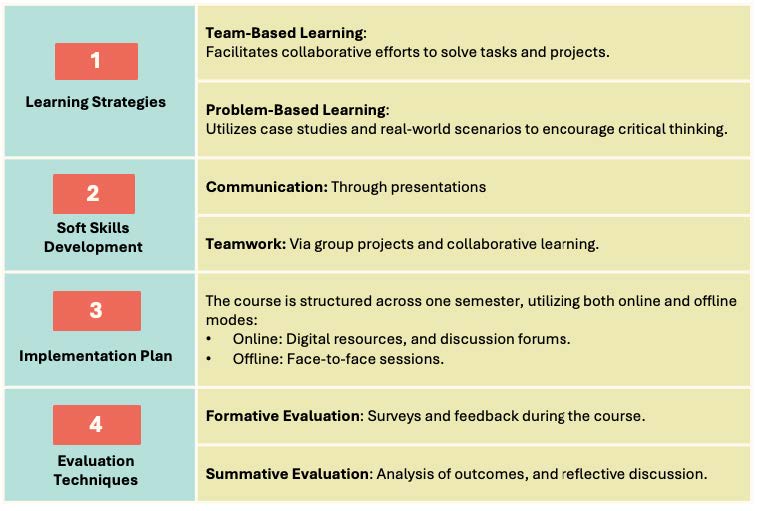Dr. Fetty Fitriyanti Lubis, S.T., M.T.
STE-ITB
Abstract
The shift from a teacher-centered approach to a student-centered learning model should be executed to improve student engagement in the Information Technology Operational Management Service course. Nevertheless, SCL alone is insufficient. Currently, students must acquire soft skills to progress in their employment. Separating soft skills training from theoretical education undermines the efficacy of the learning process; therefore, it is essential to integrate both components. The integration of Student-Centered Learning (SCL) and soft skills is essential to improve the learning experience for postgraduate students. This study proposed instructional content to develop analytical problem-solving and collaborative skills in the Information Technology Operational Management Service course. Student-Centered Learning approaches, including Team-Based Learning and Problem-Based Learning, are employed in conjunction with soft skills to establish a holistic educational framework. Evaluations, both formative and summative, demonstrate the efficacy of these strategies.
Keyword: Student-Centered Learning, Soft Skills, postgraduate student, Problem Solving.
Introduction
Enhancing Course Design is essential in today’s educational landscape. Especially for graduate education in the course of Information Technology Operational Management Service requires an engaging methodology that harmonizes theoretical understanding with actual implementation. Because many students still lack the sofskills that needed in their professional live.
SCL emphasizes the role of learners in their own education. By focusing on their needs, interests, and learning styles, educators can create a more engaging and effective learning experience that promotes critical thinking and problem-solving skills. Moreover, SCL offers a dynamic setting in which theoretical concepts are implemented in practical situations. The incorporation of soft skills, including communication, teamwork, and leadership, equips students to effectively navigate hurdles in their professional lives.
Soft skills such as communication, teamwork, and adaptability are crucial in the course of Information Technology Operational Management Service. Integrating these skills into course design prepares students for real-world challenges and enhances their employability in a competitive job market.
To effectively integrate student-centered learning and soft skills, this research employed strategies such as problem based learning, peer assessments, and team-based learning. These methods encourage active participation and practical application of skills in realistic scenarios.
Assessing student progress in a student-centered environment requires innovative approaches. This research utilized the formative assessment, self-reflections, and peer feedback that can provide valuable insights into student learning and the development of soft skills.
Research Method

Perusahaan X’fl. sebuah perusahaan teknologl informasi, menghadapi tantangan dalam meningkatkan efisiensi layanan dukungannya. Untuk mengatasi hal ini, perusahaan memutuskan untuk menerapkan sistem pengukuran kinerja yang lebih robust Mereka memfokuskan pada tiga metrik utama: Time to Resolve (TTR). First Call Resolution (FCR). dan Availability.
Setelah penerapan sistem pengukuran baru selama enam bulan. perusahaan mengumpulkan data berikutRata•rata TTR berkurang dari 4 jam menjadi 3 jam.Persentase FCR meningkat dari 65% menjadi 75%.Availability sistem meningkat dari 95% menjadl 98%.
Pertanyaan Studi Kasus:
1. Analisis Konteks:
Bagaimana pengukuran kinerja, khususnya metrik TTR. FCR. dan Availability, dapat membantu Perusahaan X’fZ dalam mengatasi
tantangan efisiensi layanannya?
2. Evaluasi Pendekatan Pengukuran.:
Mengapa pemilihan metrik TTR. FCR. dan Availability relevan dengan tantangan yang dihadapi Perusahaan XYD
Bagaimana implementasi pengukuran kinerja ini bisa mempengaruhi operasional dan keputusan strategis di perusahaan?
3. lnterpretasi Data:
Berdasarkan data yang diberikan, analisis peningkatan atau perubahan dalam TTR. FCR. dan Availability.
Apa implikasi dari perubahan ini terhadap kualitas tayanan ITT
4. Kesimpulan dan Rekomendasi:
Berdasarkan hasil yang diperoleh, apa kesimpulan yang bisa diambil mengenai efektivitas sistem pengukuran kinerja yang diterapkan?
Apa rekomendasi Anda untuk langkah selanjutnya bagi Perusahaan ~z untuk terus meningkatkan kinerja layanan Tl-nya?
5. Refleksi Organisasi:
Jika Anda adalah manajer TI di Perusahaan X’fZ. langkah apa yang akan Anda ambit untuk memastikan bahwa pengukuran kinerja terus memberikan insight yang berharga untuk peningkat.an berkelanjutan?

Discussion & Result
Preliminary findings indicate that the integration of SCL and soft skills fosters deeper engagement and application of knowledge. Students demonstrate improved critical thinking, and collaboration.
The approach also encourages active participation and enhances satisfaction with the learning process. Key results include:
- Increased student satisfaction (as indicated by feedback).
- Enhanced problem-solving and analytical skills (based on evaluations).
- Growth in soft skills (measured through peer and educator assessments).
Conclusion
Integrating SCL and soft skills into graduate courses significantly enhances the learning experience. By emphasizing practical applications and professional competencies, students are better prepared to tackle challenges in the course of Information Technology Operational Management Service. Future work will focus on refining these methods based on longitudinal data and extending their applicability to other courses.